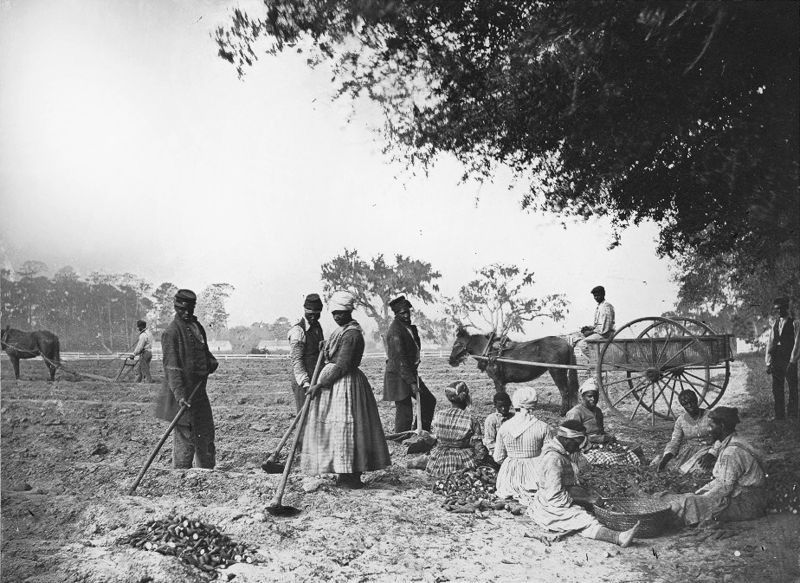From the stem to the bud
Words: Magdalena O'Neal
Yams 101
It’s time to decolonize, demystify, and debunk all the misinformation around yams.

Image Credit: New Line Cinema. Soul Food (1997)
The History
Yams are among the most misunderstood ingredients across the African diaspora. Come Thanksgiving, they’re a staple on many Black dinner tables—baked under marshmallows, drizzled with honey, or simmered slowly in fresh orange juice and brown sugar. However they’re served, they represent a rich tradition, paying homage to the ancestors who relied on the tuber for sustenance during the transatlantic slave trade. Still, it may come as a surprise—especially to those who candy them every year—that these beloved dishes often don’t contain yams at all.
To begin to unpack the cultural and historical significance yams hold in Black, African, and Latin communities, we must first acknowledge the widespread confusion between yams and sweet potatoes. Though they share certain characteristics, the two are distinct—and have, over time, become interchangeable in much of Black American culinary traditions.
In many West and Central African cultures, yams symbolize vitality, health, and longevity. They’re essential to rituals marking birth, marriage, death, and nearly every life event in between. Practical in nature—easy to prepare, highly adaptable in flavor, and remarkably shelf-stable—yams also offer a range of nutritional benefits.
Rich in potassium, manganese, copper, and vitamin C, yams have been shown to support cognitive health and overall wellbeing. Keep reading as we explore the cultural importance of yams, their entanglement with colonization, and how we can reconnect with them—through both our kitchens and our cultural practices.
What Are Yams?
Yams have earned their place as a cornerstone of global cuisine, with deep roots, both literally and culturally, across continents.
Yams are tubers, which have thickened underground stems that store nutrients and energy for the plant. This makes them not only hearty and filling, but naturally long-lasting, which contributes to their importance in food security across many regions.
Botanically, yams are starchy tuberous roots from the Dioscoreaceae family, native to Africa and Asia. As they mature, the plants produce long, cylindrical tubers underground, harvested after several months of growth.
Cultivation practices vary and range from traditional methods passed down through generations to modern agricultural innovations. In many regions, yam farming is not only a dietary necessity but also an economic lifeline.
This resilient tuber has been consumed across Africa for over 10,000 years. In countries like Nigeria and Ghana, yams remain central to daily meals and ceremonial feasts alike—an enduring symbol of nourishment, tradition, and cultural continuity.
Sweet Potatoes and Yams
in the United States
In the United States, yams and sweet potatoes are often used interchangeably—but the confusion runs deeper than just semantics. While candied yams are a beloved Thanksgiving staple, particularly within the Black community, they’re typically made with sweet potatoes. The dish, while misnamed, still serves as a powerful nod to ancestral traditions and resourcefulness.
Although both are tuberous roots, yams and sweet potatoes differ significantly in origin, appearance, texture, and taste. Yams are native to Africa and Asia, while sweet potatoes originate from the Americas. Despite these differences, the terms became entangled—especially in North American markets—where orange-fleshed sweet potatoes were marketed as “yams” to distinguish them from paler varieties.
Dr. Jessica B. Harris explores this culinary and cultural crossover in her New York Times essay, You Say Potato, I Say Yam, noting:
“Sweet potatoes are New World tubers that were adopted by enslaved Africans on the American continent. They could be grown in the temperate climates; they could be stored in mounds and used as needed to supplement meager rations. When cooked in the ashes of a dying fire, they were a sweet treat at the end of a bone-tiring day of toil. Most important, sweet potatoes were taken to the hearts and stomachs of Africans and their descendants in the United States because they recalled the true yam of Africa.”
Over time, sweet potatoes became deeply rooted in the culinary landscape of Black America, particularly in the South. Beyond sustenance, they became symbols of endurance, memory, and adaptation. Whether used in stews, casseroles, or classic desserts like sweet potato pie, they carried with them a history of survival and cultural continuity.
Yams in Global
Cuisines and Cultures
In West Africa, yams are more than just a food source—they are central to cultural identity and tradition. They are often boiled, mashed, or pounded into a dough-like consistency to create fufu, a staple served alongside rich soups and stews. Yams are also used in popular regional dishes such as yam porridge and yam pottage, and they frequently appear in celebratory meals, especially during yam festivals and community gatherings that mark the harvest season.
Across the Caribbean, yams remain a key ingredient in a number of beloved dishes. In Jamaica, for example, they’re featured in classics like yam and saltfish, yam pie, and hearty soups. Caribbean preparations often incorporate coconut milk, spices, and meats, which transform the starchy tuber into flavorful and satisfying meals that speak to the region’s culinary complexity and African heritage.
In the Pacific Islands, yams are commonly roasted, steamed, or boiled, and served alongside fish or meat. In Papua New Guinea, they are a staple of everyday meals, while in Fiji, yams are sometimes grated and used in desserts such as cassava cake, or added to savory dishes like kokoda, a ceviche-style preparation that balances the yam’s earthiness with citrus and fresh seafood.
Latin American cuisines also feature yams in a variety of ways, with regional variations across countries like Brazil, Colombia, and Peru. In Brazil, dishes such as cará, a creamy yam-based soup, showcase the tuber’s versatility, while in Peru, yams are used in dishes like causa, a layered potato dish, or added to brothy stews that highlight native ingredients and techniques.
From West Africa to the Caribbean, the Pacific Islands to Latin America, yams have evolved within each culinary tradition while retaining their core significance as a source of sustenance, history, and community.
Yam Talk:
Change the Narrative
For Black Americans, embracing yams—not just as an ingredient, but as a cultural touchstone—offers a meaningful way to reconnect with ancestral heritage. Long before they were misnamed or misunderstood, yams nourished generations across West and Central Africa, sustained enslaved people during the transatlantic slave trade, and quietly rooted themselves in African American culinary traditions. Reclaiming them is not just about setting the record straight—it’s about honoring resilience, survival, and identity through food.
Nutritionally, yams deliver too—they’re rich in complex carbohydrates, fiber, and essential vitamins and minerals. But their value extends beyond what’s on the nutrition label. Incorporating yams into your meals is a celebration of lineage and legacy. It’s a reminder that food is history, memory, and medicine—all at once.
This isn’t a call to ditch the candied "yams" that show up at Thanksgiving—those dishes have their place, their nostalgia, and their own form of reverence. But it is an invitation to go deeper. Try introducing a traditional yam dish into your weeknight rotation or family gatherings. Learn about the real yam’s role in our story, and help rewrite how it shows up in our kitchens today.
Reclaiming the yam isn’t just about what we eat. It’s about how we remember, and how we move forward, one meal at a time.









